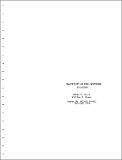| dc.contributor.author | Hoult, David P. | |
| dc.contributor.author | Kranz, William T. | |
| dc.date.accessioned | 2005-09-15T20:46:03Z | |
| dc.date.available | 2005-09-15T20:46:03Z | |
| dc.date.issued | 1974 | |
| dc.identifier.other | 16203745 | |
| dc.identifier.uri | http://hdl.handle.net/1721.1/27289 | |
| dc.description.abstract | This report develops a simple physical model that predicts that the
nighttime dispersion of S2 from the largest sources in Boston is different
than the dispersion of S2 from small, low level sources. Diurnal variations in S02 levels measured in Boston over the last seven years are analyzed
in the light of this theory. The comparison between theory and observation
is favorable. A simple, unambiguous, criteria for defining a large source
is developed. The results are used to predict the fraction of the time
large sources could burn high sulfur fuels while still meeting the state
standards for sulfur dioxide. | en |
| dc.format.extent | 2909954 bytes | |
| dc.format.mimetype | application/pdf | |
| dc.language.iso | en_US | en |
| dc.publisher | MIT Energy Lab | en |
| dc.relation.ispartofseries | MIT-EL | en |
| dc.relation.ispartofseries | 74-001 | en |
| dc.subject | Sulphur dioxide | en |
| dc.subject | Air -- Pollution in Boston Metropolitan Area | en |
| dc.subject | Fuel research | en |
| dc.title | Feasibility of fuel switching in Boston | en |
| dc.type | Technical Report | en |

